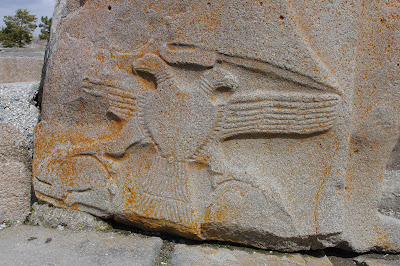Yazilikaya (the written rocks), National sanctuary of the Hittite Empire
Located a short distance from
Hattusas, Yazilikaya (the “inscribed
rocks”) was the official temple and sanctuary of the Hittite empire. It
consists of several rock-cut chambers carved around a large rocky outcrop
possessing two large alcoves and an open-air sanctuary. Both alcoves contain
reliefs of Gods and Goddesses in a parade, all appearing by profile. It is
possible that some of the smaller alcoves were used for burial of the deceased
Kings, and that the whole sanctuary was therefore a funerary monument built to
celebrate some Royal ancestors.
One notable
relief depicts a King (perhaps Tudhaliya
IV or III) greeted by the God Sharruma. Other depictions include
representations of the Sword-God and the 12-Gods believed to symbolize the 12
months of the year. All of the figures portrayed in the sanctuary at Yazilikaya
are wearing long robes and a kind of conical headdress somehow similar to
priestly head-dresses one finds amongst the Phrygians and the ancient kingdom
of Commagene (which only made their
appearance many centuries later)
Alaca Hoyuk, the Riddle of the Sphinx Gate
Alaça Hoyuk, located some 25 Km
from Hattusas, was a major city of Hatti and the Hittite empire. Alaça Hoyuk
was apparently settled already in the Neolithic period, with the earliest
monumental remains belonging to to a number of “royal” or princely graves dated
to 2,350 BC. Just like nearby Hattusas,
the site fell victim to a devastating fire by 1,200 BC, but unlike Hattusas was
later resettled in Phrygian times.
The most famous
monument is the so-called “Sphinx gate”, built in Egyptian style possibly by
1,450 BC. This was a monumental gateway to the ancient city also consisting of
a massive polygonal wall decorated with bas-reliefs on its outer side. Carvings
include a king and queen worshipping the sacred bull, priests, jugglers,
charioteers and a rather odd depiction of a man climbing a ladder towards a
circular ring standing freely in space. On the two orthostats are depictions of
human-headed Sphinxes wearing a kind of Egyptian headdress, with the two-headed Eagle to symbolize Royal
power. One of the most striking features is however the impressive polygonal
wall running on the interior side of the Gate: consisting of huge andesite
stones weighing well over 5 tons, it also bears an uncanny resemblance to Inca
stone masonry architecture…One wonders whether this wall may actually predate
construction of the gate by the Hittites.
 |
| One of the most interesting details is this representation of a two-headed eagle, itself a symbol of royal power - (Photo by Author) |
After bypassing
the Sphinx gate, one is led through a large paved road towards the great
Temple, still mostly unexcavated. Only a few large megalithic blocks remain,
also bearing cup-marks and drill holes as most stones in Hattusas.
Also in Alaça
Hoyuk one finds a vaulted underground tunnel of unknown function (it has been
suggested it also was used as a poterne
in case of siege), which is almost L-shaped and cannot therefore have served
any astronomic purpose.
Another
interesting feature of the site are several early-bronze age tombs, taking the
shape of large rectangular pits which have been remarkably reconstructed and
preserved in-situ, including remains
of sacrificed bulls and cattle. These tombs have yielded a number of artifacts
and funerary objects, including several bronze and copper “standards” and
“Sun-disks” with an intricate geometric carving and figures of stags (whose
ultimate function also remains unknown, even though they were probably used in
processions or at the top of a pole as a kind of standards)
There is also a
small, yet fascinating museum on the site (the
originals of the Hittite bas-reliefs carved on the outside of the Sphinx gate
are now on exhibit in the Anatolian Civilization Museum in Ankara, with the
exception of the two Sphinx statues which are still in their original position).
 |
| Ankara, Museum of Anatolian Civilizations, late-Hittite reliefs depicting a procession of dignitaries and soldiers (originally from Karkemish, near present day Syria) - (Photo by Author) |
 |
| Ankara, Museum of Anatolian Civilizations, one of the mysterious hittite Sun-disks (originally from Alaca Hoyuk) with a typical grid-like pattern and stags ornamentations - (Photo by Author) |
 |
| Ankara, Museum of Anatolian Civilizations, a hittite ceremonial standard (originally from Alaca Hoyuk) depicting stags with innaturally long horns - (Photo by Author) |
 |
| Ankara, Museum of Anatolian Civilizations , one of very few hittite golden objects. This small gold vessel contains an elaborate ornamentation, including triangles and a swastika - (Photo by Author) |
 |
| Ankara, Museum of Anatolian Civilizations, large hittite boundary stone with hieroglyphic inscription in Luwian characters - (Photo by Author) |











No comments:
Post a Comment